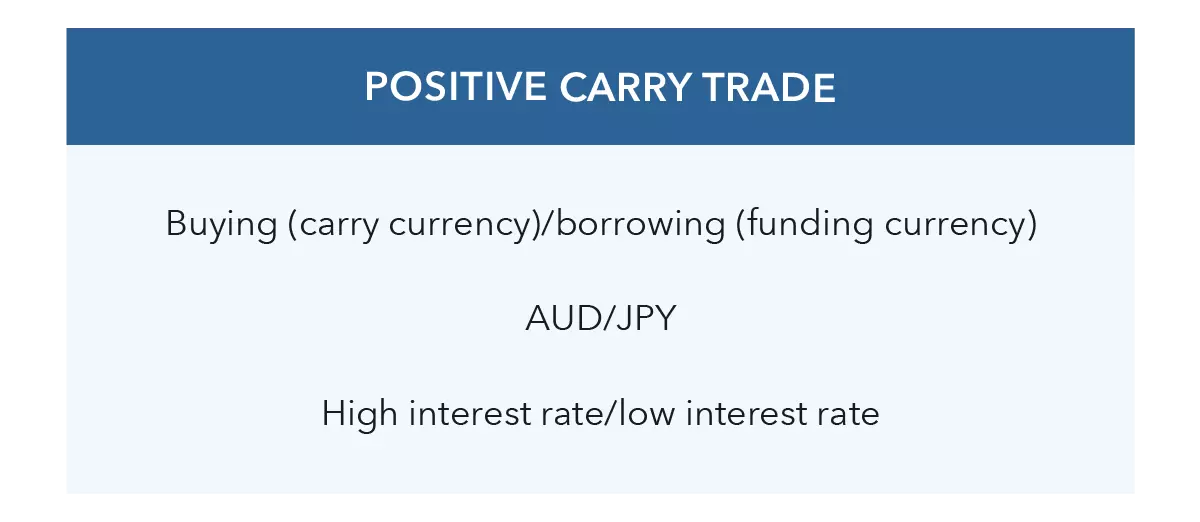What is the best currency carry trading strategy?

What is a carry trade in forex?
A carry trade in forex involves a trader attempting to profit from the difference in interest rates – known as the interest rate differential – between the two currencies in a forex pair. There are two main strategies for a carry trade in forex: positive and negative.
Positive carries involve borrowing a currency with a low interest rate while buying a currency with a high interest rate. Traders enter a positive carry on the assumption that the higher interest rate currency will remain the same or appreciate.
Initially, a negative carry will incur a net loss as the trader will have to pay interest for holding the position, but this could turn into a net gain that offsets any losses incurred if the higher interest rate currency depreciates relative to the lower interest rate currency.
How do currency carry trades work?
Currency carry trades work by enabling market participants to profit from interest rate differentials between the different currencies in a forex pair. Because forex is always traded in pairs, traders are simultaneously selling one currency while buying another. It is this technicality in forex transactions which makes currency carry trades possible.
When dealing forex, the currency on the left of the pair is known as the base currency, and the currency on the right of the pair is the quote. The price given for a forex pair is always the price of how much of the quote currency a trader would have to spend in order to buy one unit of the base currency.
For example, the two most popular currencies used in a positive currency carry trading strategy are AUD/JPY and NZD/JPY. These pairs set AUD or NZD as the base currency, and JPY as the quote. This means that if you were attempting a positive carry trade on these pairs, you would be borrowing Japanese yen and buying Australian dollars or New Zealand dollars.
Typically in a carry trade, traders will borrow a currency with a low interest rate while at the same time, they will buy a currency with a high interest rate. As part of a currency carry trade, the currency which the trader is borrowing is known as the funding currency, and the currency they are buying is known as the carry currency. By borrowing one currency and buying another simultaneously, the trader will incur interest on their capital relative to the differential between the interest rates of the quote and base currency in a pair.
Depending on whether the carry is positive or negative, the trader will either incur positive or negative interest on their position in the form of a net gain or a net loss.
Currency carry trading strategy
Let’s look at two separate examples for the two types of currency carry trading strategy – positive and negative.
Positive carry trading strategy
This strategy involves borrowing a currency with a low interest rate and buying a currency with a high interest rate. Often, this strategy is used on the AUD/JPY currency pair – in which a trader will borrow Japanese yen at low interest and buy Australia dollars at high interest. For the sake of this example, let’s assume that The Bank of Australia has set interest rates at 5%, while the Bank of Japan (BoJ) has set interest rates at 0.5%.
This means that this currency pair has a 4.5% positive carry value to the trader. Suppose the trader’s initial position is worth 6000 Australia dollars, this means that they will receive 4.5% of 6000 as interest on top of any currency appreciation in the pair. This means that they will receive 270 Australian dollars directly into their trading account as interest for holding the position.

In a positive carry trade, you will receive an initial net gain as you are paid interest for holding the position. However, this could reverse if the interest rate of the base currency falls and the interest rate of the quote currency rises. In this case, the interest rate in Australia would need to fall below the interest rates in Japan.
Negative carry trading strategy
This strategy involves borrowing a high interest currency and buying a low interest currency on the assumption that the currency with the lower interest rate will appreciate relative to the currency with the higher interest rate.
Because of the nature of the forex market in which the major currencies such as the American dollar, euro, British pound or Swiss franc are often used as the base currency, a negative carry trading strategy will usually have a tighter interest rate spread compared to positive carry trades.
For the sake of this example, let’s assume that you notice that the interest rate on the British pound is currently 0.8%, and the interest rate on the US dollar is currently 1.3%. This means you will incur a negative carry of –0.5%. As a result, you take a position on the GBP/USD currency pair and you borrow the higher interest rate US dollar and buy the lower interest rate British pound. You would do this on the assumption that the interest rate of the pound will rise above that of the dollar, in which case you would profit.
However, while a positive carry trade results in an initial net gain with a potential net loss, a negative carry trade results in an initial net loss with a potential net gain. This is because you would be paying interest on your position until the interest rate on the base currency increased above that of the quote. In this case, interest rates set by the Bank of England (BoE) would need to rise above those set by the US Federal Reserve (Fed).
How to place a currency carry trade
Follow the steps below to place a currency carry trade:
- Decide how you’d like to trade forex
- Research the pair you’d like to trade
- Create a trading account
- Take steps to manage your risk
- Open, monitor and close your position
Learn more about how to trade forex
What are the best forex pairs for carry trading?
For a positive currency carry trading strategy, forex pairs with a higher interest currency as the base and a low interest currency as the quote are preferred.
Alternatively, good forex pairs for negative currency carry trading are those in which the quote currency has a higher interest rate than the base currency.
Pros and cons of currency carry trades
Pros of currency carry trades
The main benefit of currency carry trades is that, as well as potentially profiting from any differences in price between the two currencies in the pair, you are also accruing interest on your active position.
Also, if you have opened your position using leverage, the interest that you gain will be based on the full size of your position rather than the deposit that was required to open it. However, please remember that while leverage can magnify your gains, it can also amplify your losses.
Learn more about leveraged trading
Cons of currency carry trades
Some of the currencies that are used in currency carry trades are extremely volatile, which can make this strategy risky – especially in times of economic uncertainty. Equally, interest rate decisions are at the discretion of a country’s own central bank, which means that if the interest rate spread between the two currencies in a transaction is narrow, a carry trade that is receiving interest can quickly result in a net loss.
If the currency that you are borrowing as part of a positive currency carry trade suddenly strengthens against the currency in its pair, you could find yourself at a large loss. As a result, you should take steps to manage your risk when trading.
Learn more about risk management
Currency carry trades summed up
- There are two types of currency carry trading strategy: positive or negative
- Positive currency carry trades are more conventional, and involve borrowing a currency with a low interest rate and buying a currency with a higher interest rate
- Negative currency carry trades are less popular, and they involve borrowing a currency with a high interest rate and buying a currency with a lower interest rate
- Both forms of currency carry trade attempt to profit from the interest rate differential between two currencies in a currency pair
- Traders should keep up to date with any latest interest rate announcements as part of their analysis of currency carry trades, because any changes in interest rate could affect the profitability of a position
This information has been prepared by tastyfx, a trading name of tastyfx LLC. This material does not contain a record of our trading prices, or an offer of, or solicitation for, a transaction in any financial instrument. You should not treat any opinion expressed in this material as a specific inducement to make any investment or follow any strategy, but only as an expression of opinion. This material does not consider your investment objectives, financial situation or needs and is not intended as recommendations appropriate for you. No representation or warranty is given as to the accuracy or completeness of the above information. tastyfx accepts no responsibility for any use that may be made of these comments and for any consequences that result. See our Summary Conflicts Policy, available on our website.
